Benin Bronze Mask of a Leopard with Bells, 18th Century CE - 19th Century CE
Bronze
36 x 20 cm
14 1/8 x 7 7/8 in
14 1/8 x 7 7/8 in
LK.167
Further images
The kingdom of Benin can justifiably lay claim to having produced the finest artists and craftsmen in the history of the African continent. Yet this heritage was scarcely recognised until...
The kingdom of Benin can justifiably lay claim to having produced the finest artists and craftsmen in the history of the African continent. Yet this heritage was scarcely recognised until the British punitive expedition of 1897, which destroyed and looted the ancient city compounds and in so doing brought the achievements of Benin to the world’s attention (Bacquart 1998). The foundation of the Benin peoples was contemporary with the European late mediaeval period, when the kingdom of Benin was founded by a descendent of an Ife king in c.1180 AD. In the 15th and 16th centuries AD the power of the empire stretched across most of West Africa, and those areas not under their control were indirectly influenced by the effect of their trade networks and material culture styles. Until the late 19th century, the Benin centres were a ruling power in Nigeria, dominating trade routes and amassing enormous wealth as the military and economic leaders of their ancient empire.
Benin history, religion, and political structure are brought to life every year in a series of palace rituals intended to purify the kingdom and renew the spiritual powers of the king, the oba. Many of these vivid and solemn rites were introduced by individual obas in order to commemorate events in their reigns and to promote important principles in the ideology of divine kingship. At these palace festivals, the powers of the king, the roles of the various chiefs and titleholders, and the relationships between them are displayed for all to see. The arts play an important role in these rituals. The king and other participants wear their most lavish ceremonial costumes, consisting of vast quantities of costly imported coral beads, luxurious textiles, and ornaments made of gleaming brass and creamy ivory. This ornament in the shape of a leopard's head was part of such a costume.
Benin history, religion, and political structure are brought to life every year in a series of palace rituals intended to purify the kingdom and renew the spiritual powers of the king, the oba. Many of these vivid and solemn rites were introduced by individual obas in order to commemorate events in their reigns and to promote important principles in the ideology of divine kingship. At these palace festivals, the powers of the king, the roles of the various chiefs and titleholders, and the relationships between them are displayed for all to see. The arts play an important role in these rituals. The king and other participants wear their most lavish ceremonial costumes, consisting of vast quantities of costly imported coral beads, luxurious textiles, and ornaments made of gleaming brass and creamy ivory. This ornament in the shape of a leopard's head was part of such a costume.





